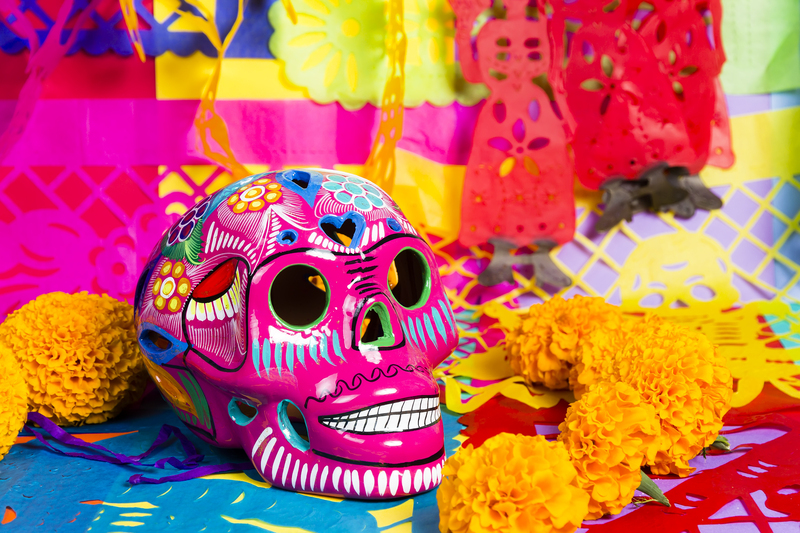How Red Roses Became Synonymous with Valentine's Day
Posted on 01/06/2025
How Red Roses Became Synonymous with Valentine's Day
When it comes to Valentine's Day, few symbols are as universally recognized as the red rose. This stunning flower, with its vibrant hue and intoxicating fragrance, has become the quintessential gift of love and passion exchanged between sweethearts each February 14th. But have you ever stopped to wonder: How did red roses become the floral face of Valentine's Day? In this comprehensive article, we'll delve into the intriguing history, cultural influences, and commercial traditions that have linked this romantic bloom so tightly with the most heartfelt holiday of the year.

The Historical Roots of Red Roses in Romance
Ancient Beginnings: Red Roses in Mythology and Legend
The tale of the red rose and romance reaches deep into antiquity. The flower made its debut in ancient mythology, particularly in Greek and Roman legends, where it was inextricably tied to Aphrodite (Venus), the beautiful goddess of love. According to myth, the first red roses were said to grow from Aphrodite's tears and the blood of her lover, Adonis, symbolizing both profound love and tragic loss.
In Roman society, giving roses was considered a declaration of deep passion, and the flower itself was seen as an emblem of both secrecy and desire. The phrase "sub rosa" (literally, "under the rose") evolved to mean secrecy or confidentiality, as roses were often hung from the ceiling during private discussions among lovers or conspirators.
- Roses were sacred to numerous love deities, including Isis in Egypt and Eros in Greece.
- The use of red roses in courtship and marriage ceremonies can be traced back thousands of years.
The Symbolic Color: Why Red Stands for Love
While roses exist in myriad colors, it is the red blooms that have captivated hearts throughout the ages. The color red carries a deep psychological effect, universally associated with strong emotion--most notably love, passion, and devotion. From ancient art and poetry to religious texts, red has consistently been used to represent the intensity and fervor of romantic attraction.
In many cultures, presenting red roses expresses far more than words can convey. Red, with its bold brilliance, visually communicates affection and the boldness of expressing strong feelings--a key reason why it became the go-to flower for Valentine's Day.
The Connection Between Saint Valentine and the Red Rose
Who Was Saint Valentine?
The link between Saint Valentine and romantic love is a story steeped in mystery, history, and more than a dash of legend. The name "Valentine" refers to at least two Christian martyrs recognized for their compassion and acts of kindness. The most popular legend involves a priest named Valentine, who performed secret marriages for Roman soldiers against the emperor's decree and was eventually executed for his actions.
Early Valentine Traditions and Floral Gifts
In Medieval Europe, the connection between Valentine's Day and romantic love began to solidify, partly due to the poetry of Geoffrey Chaucer, who wrote about birds choosing their mates on "Saint Valentine's Day." This, in turn, influenced courtly traditions, where couples exchanged tokens of affection, including flowers.
- Roses, especially red ones, became a central motif in early love poetry and art.
- Lovers would exchange pressed flowers and notes as early Valentine's gifts.
By the 17th and 18th centuries in England and France, it became popular to give bouquets of flowers as declarations of love on February 14th. As the flower most closely associated with heart-stirring passion, the red rose's role was cemented.
The Language of Flowers: "Floriography" and the Rise of the Red Rose
What is Floriography?
The tradition of communicating deep emotions and unspoken sentiments through flowers--known as floriography--reached its peak during the Victorian Era. In an age when reserved social norms kept romantic expression in check, flowers became a subtle yet powerful way to convey feelings that etiquette prevented lovers from voicing aloud.
Each flower, and even each color, held distinct meaning. In the Victorian "language of flowers," the red rose triumphed as the ultimate symbol of passionate love:
- Red roses signified pure, unmistakable love and deep respect.
- White roses meant innocence and new beginnings.
- Yellow roses stood for friendship and joy.
In a bouquet, a single red rose elegantly stated: "I love you." This secret code added an extra dimension to the act of giving roses on Valentine's Day.
How the Red Rose Became Valentine's Most Popular Flower
Publishers in Europe and America produced flower dictionaries and guides throughout the 19th century, making the meanings of blooms widely known. As Valentine's Day grew in popularity as a day for courtship and confession, the red rose, presented alone or in a lavish bouquet, climbed to the top of the gift list.
Florists capitalized on the Victorian passion for flower symbolism, marketing red roses specifically as the flower of love for Valentine's Day. This tradition only grew stronger with advancements in international flower transport, providing access to fresh roses around the globe.
Modern Marketing: Red Roses as the Global Valentine's Icon
The 20th Century Flower Industry
The 20th century saw incredible growth in the global flower trade. As logistics improved, it became feasible to supply fresh red roses worldwide, timed perfectly for Valentine's Day. Media campaigns, advertisements, and movies further embedded the red rose as the essential Valentine's Day gesture.
- By the mid-1900s, businesses began large-scale marketing of red roses for Valentine's Day.
- Hollywood films and popular culture fueled the image of the passionate rose bouquet.
- Card companies and florists established red rose imagery in Valentine's promotions and products.
Current Trends: The Red Rose Bouquet Today
Today, giving a dozen red roses symbolizes the ultimate in romantic love. Florists offer countless creative arrangements, but the classic bouquet of long-stemmed, velvety red blooms remains the bestseller for Valentine's Day worldwide.
In fact, data shows that over 250 million roses are produced specifically for Valentine's Day each year, with more than 70% of these being richly-hued red roses. The association is so ingrained that for many, Valentine's Day wouldn't feel complete without them.
The Deep Meaning of Red Roses Beyond Valentine's Day
Red Roses in Culture, Literature, and Art
The red rose's connection to romance far outstrips a single holiday. From Shakespeare's famous sonnets to countless wedding celebrations, the red rose endures as a timeless motif for love, longing, and devotion. Artists and poets across centuries have invoked the rose as an enduring image of beauty and passionate connection.
Some famous allusions include:
- Shakespeare's line: "A rose by any other name would smell as sweet" in Romeo and Juliet.
- The rose's pivotal role in folk tales, fairy tales, and religious symbolism.
Even outside the context of Valentine's Day, red roses inspire grand gestures, commemorate anniversaries, and serve as expressions of admiration and respect worldwide.
Alternative Valentine's Flowers: Why Do Red Roses Endure?
While other flowers have their devotees--tulips for affection, lilies for purity, orchids for exotic elegance--none hold the same universally-acknowledged symbolism as the red rose when it comes to expressing romantic love. Societal traditions, centuries of art and literature, and modern marketing have together ensured the red rose's status as the torchbearer of Valentine's affection.

Choosing the Perfect Red Roses for Valentine's Day
If you're planning to give roses this Valentine's Day, here are some tips for selecting the perfect bouquet:
- Opt for fresh, long-stemmed red roses with vibrant color and firm petals.
- Consider the number of roses: a single rose for new love, a dozen for devotion, or two dozen for dramatic flair.
- Add a personalized note to make the gift even more meaningful.
- Pair the roses with chocolates, wine, or another thoughtful gift for a truly memorable gesture.
If you'd like to mix things up, combine red roses with white or pink blooms, symbolizing unity and admiration alongside passion.
Conclusion: Why Red Roses Remain the Heart of Valentine's Day
From their mythological origins and ties to ancient goddesses of love, to their coded language in Victorian times and their starring role in modern holiday marketing, red roses have become the ultimate signifier of romantic affection on Valentine's Day. Their beauty, evocative color, and rich history ensure that red roses will continue to reign as the flowers of choice for generations of lovers yet to come.
So the next time you hand someone a single red rose or a bountiful bouquet on February 14th, remember: you are part of a tradition that spans continents and centuries, communicating far more than words ever could. The synonymous relationship between red roses and Valentine's Day is a testament to humanity's enduring desire to love, cherish, and be remembered--in the language of blooms.
Frequently Asked Questions About Red Roses and Valentine's Day
- Why are red roses considered the flower of love?
The red rose has long been associated with love due to its historical connections to romantic myths, its prominent use in literature, and its passionate color that visually represents deep feelings. - Are other colors of roses given on Valentine's Day?
Yes, though red remains the most popular, pink roses (admiration), white roses (innocence), and yellow roses (friendship) are also exchanged. For romance, red is still the top choice. - How did red roses become the main flower for Valentine's Day?
Through centuries of tradition--including mythology, poetry, floriography, and modern marketing--the red rose became the recognized symbol of romantic love, cementing its place as the iconic Valentine's Day flower.
In summary, the story of how red roses became synonymous with Valentine's Day is a fascinating blend of history, mythology, symbolism, and love--making every bouquet a part of an ancient, enduring tradition.
Latest Posts
Sunflowers: more than just a pretty face, discover why
Create a Green Oasis with Minimal Effort Office Plants
The Hidden Meanings of Birth Flowers: What Yours Means for You





